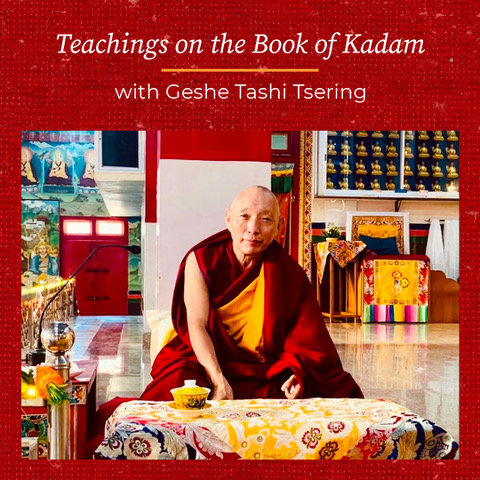In this series, Khen Rinpoche Geshe Tashi Tsering, abbot of Sera Mey monastery, gives a series of classes on a reading from The Book of Kadam, also known as The Miraculous Book of Kadam, attributed to Lama Atisha and Geshe Dromtönpa. He comments on Chapter 15 of The Jewel Garland of Dialogues: How to Train the Mind within the Expanse of Appearance, Emptiness and Empty Echoes.
As usual, Geshe Tashi’s style is part scholarly – he brings an exceptional depth of knowledge, experience and wisdom to the material; and a large part down to earth – how we can best apply these teachings to our everyday lives.
In this class, Geshe Tashi begins with some inspiring words on making the most of this fortunate life of ours, and then gives a re-cap of the dream story last week. Why is this story relevant to us? We perceive things and events like a child would seeing a magician on stage, he says, we are completely taken in. To reduce our attachment and aversion, then, we should see this trick at for what it is.
This is like our own dreams, Geshe la says. We experience them as real.
Geshe la points out how the protagonist in the story, Sriman, starts to have doubts, and why doubt (and constant questioning) is important for us too. He says we need these doubts because our society, language and culture keep reinforcing the mistaken belief that things exist as they appear. And just as Sriman thinks his wife must be deceiving him, we think, ‘surely we can’t be mistaken all the time, how we see things must be true.’ This is because our grasping to appearance as being true is so strong.
Just as the man goes to check the yarn for himself, so must we investigate and analyse all we see, hear, touch and believe.
As an aside, Geshe la says this is one of two recognised ways of teaching in the Buddhist tradition, that of teaching through experience. The student is expected to try out the teachings for him or herself, and then report back, while the experience is still at the forefront of the student’s mind.
Geshe la points out that this story and the teachings are not saying that all things are an illusion, but that all things are like an illusion. Interestingly, he says that if we do say all things are an illusion, we’d better be very, very clear on what being an illusion means, otherwise we will come away thinking all things and events don’t exist.
That is not to say that while the man was in the magician’s dream, he didn’t have a real experience. He did.
“The suffering of samsara is just like that.
Though seemingly real, it is just like your experience.”
Like in our own dreams, the suffering was real for him (it seemed real) at the time. In the same way in our waking lives we have seemingly real experiences of our states of mind and outer things and events as being as they appear. Even though the reality of these experiences is that (because of the way we hold to them) they are dream-like, illusion-like.
Currently, Geshe la says, our experience is very much at the level of appearances, not at the level of reality. When we start to have doubts about these appearances, like Sriman in the story, then we can begin to make progress.
While Geshe la travels there will be a two week break. We hope you will join us for our next class together on Sunday 4th December.
With best wishes,
The Admin Team
You can find details of upcoming classes as well as the text available for download here.
https://foundationsofbuddhistthought.org/

